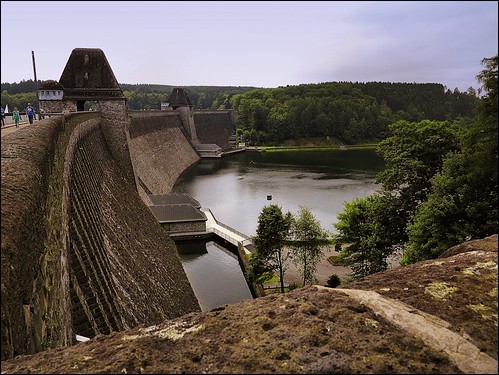My interest for the Møhne dam in the photo was raised as we last summer was taking an overnight stop in the North-Rhine Westfalia region to go for a 50km bike tour around the Møhnesee (lake).
Absolute interesting bike tour and coming to the one end of the lake we suddenly could see this old dam in the lake Møhne (the dam constructed around 1910).
Thinking back to the time of WWII it seemed almost strange that this dam should have survived the war. Which was not what the English wanted. In fact they bounce bombed the dam with great success in 1943 - it was partially destroyed and it took a lot of resources to bring it back in working order for the Germans.
This video at Youtube give you some insight with clips from the heroic movie: "The dambusters":
www.youtube.com/watch?v=JUt5ysms3sU
For anyone with an interest for more - here something from the net:
On the night of May 16th, 1943, nineteen Lancaster bombers took off from Scampton in Lincolnshire. They had three primary targets: the Möhne, Eder and Sorpe dams and two secondary ones, the Lister and the Eneppe dams. Of the nineteen planes, five would be held in reserve during the attacks.
Gibson led the first attack. At 00.56 hours, the Möhne Dam was breached and by 01.54 hours so was the Eder Dam. The Sorpe Dam was attacked by planes from the reserve force but, though hit, it held out.
Just how low the Lancasters flew during the attack is shown by the fact that one Lancaster had to turn back as it had hit the sea on the journey to mainland Europe and lost its bomb.
The attack had huge propaganda value and made Gibson a national hero. Of the nineteen Lancasters that took part in the attacks with 133 crew, eight planes were lost with the loss of 56 men; three of these men survived to become prisoners-of-war. Gibson was awarded the Victoria Cross for bringing round his Lancaster to give covering fire to the Lancasters that were following up his attack on the Möhne Dam. 33 others members of 617 squadron were also decorated.
How successful was the raid?
Severe flooding occurred where the Möhne Dam was breached. 1,200 people were killed including nearly 600 forced labourers from Eastern Europe who were housed in a labour camp near Neheim. Six small electricity works were damaged and rail lines passing through the Möhne Valley were disrupted. But industrial production was not affected in the long-term. When the Eder Dam broke, there were similar results. Kassel, an important arms producing town, was reached by the floodwater, but little actual damage was done. Had the Sorpe Dam been breached, then the damage would have been much greater. The potential for a major disaster was recognised by Albert Speer who commented that:
"Ruhr production would have suffered the heaviest possible blow."
In the short and long term, the damage done by 617 squadron was repaired quite quickly. But the most important impact of the raid was that 20,000 men working on the Atlantic Wall had been moved to the Ruhr to carry out repairs to the damaged and breached dams. This work was completed before the rains of the autumn appeared.
No comments:
Post a Comment